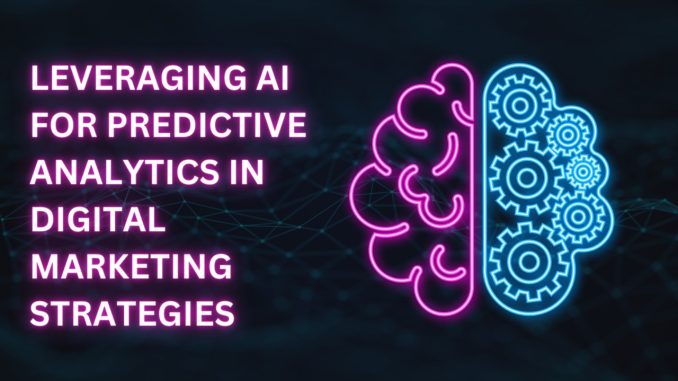
The sheer volume of data generated by businesses today is staggering, a digital ocean of information flowing from every customer interaction, operational process, and market trend. While traditional business intelligence tools could tell us what has happened, the true competitive edge in the modern economy lies in understanding what will happen. This is where Artificial Intelligence (AI), particularly its application in predictive analytics, is proving to be a game-changer. AI is transforming raw data into actionable foresight, enabling businesses to anticipate future outcomes with remarkable accuracy, optimize strategies, mitigate risks, and seize opportunities in ways previously unimaginable.
At its core, predictive analytics, powered by AI and machine learning algorithms, involves using historical data to forecast future events. Unlike descriptive analytics (which tells you what happened) or diagnostic analytics (which tells you why it happened), predictive analytics leverages complex statistical models, neural networks, and other AI techniques to identify patterns and relationships within data that can signal future trends. For businesses, this translates into a powerful ability to move from reactive decision-making to proactive strategizing, minimizing guesswork and maximizing efficiency across virtually every department.
One of the most significant impacts of AI in predictive analytics is in customer behavior forecasting and personalization. Businesses can now anticipate what a customer is likely to buy, when they might churn, or which marketing message they are most likely to respond to. AI models analyze vast amounts of customer data—including purchase history, Browse patterns, demographic information, social media activity, and even customer service interactions—to build highly accurate profiles and predict future actions. For an e-commerce retailer, this means an AI system can predict which customers are likely to abandon their shopping carts and trigger personalized retargeting ads or discount offers in real-time. Similarly, a subscription service can use AI to identify subscribers at high risk of cancellation and deploy proactive retention strategies, such as personalized content recommendations or exclusive loyalty benefits. This granular understanding allows for hyper-personalized marketing campaigns and customer experiences that significantly boost conversion rates and foster long-term loyalty.
Beyond customer-facing applications, AI-powered predictive analytics is revolutionizing operational efficiency and resource optimization. In manufacturing, AI can predict machinery failures by analyzing sensor data for subtle anomalies, enabling preventative maintenance before costly breakdowns occur. This reduces downtime, extends equipment lifespan, and optimizes production schedules. In logistics and supply chain management, AI models forecast demand fluctuations, allowing companies to optimize inventory levels, reduce waste, and streamline delivery routes. Imagine a food distributor using AI to predict which products will be in highest demand in specific regions based on weather forecasts, local events, and historical sales, ensuring fresh stock is available while minimizing spoilage. This level of foresight allows for more precise resource allocation and operational resilience.
Financial services and risk management are also being profoundly transformed by AI predictive analytics. Financial institutions leverage AI to detect fraudulent transactions in real-time by identifying unusual patterns that deviate from a customer’s typical spending habits. This proactive fraud detection saves billions annually. In lending, AI models can assess creditworthiness with greater accuracy and fairness than traditional methods, analyzing a broader range of data points to predict default risk, thereby expanding access to credit for previously underserved populations while still managing risk effectively. For investment firms, AI-driven predictive models analyze market data, news sentiment, and economic indicators to forecast asset price movements, informing trading strategies and risk mitigation decisions.
Furthermore, AI is enabling powerful predictive capabilities in human resources and talent management. Businesses can use AI to predict employee turnover by analyzing factors such as compensation, job satisfaction, management effectiveness, and industry trends, allowing HR departments to proactively address issues and implement retention strategies. AI can also predict the success of new hires based on their skills, experience, and even personality traits mapped against high-performing employees, leading to more effective recruitment and reduced onboarding costs. This strategic foresight in talent management ensures that businesses can build and retain a strong, productive workforce.
However, despite these compelling benefits, the effective implementation of AI for predictive analytics is not without its challenges. The quality and quantity of data are paramount; AI models are only as good as the data they are trained on. Inaccurate, incomplete, or biased data can lead to flawed predictions and potentially discriminatory outcomes. Businesses must invest in robust data governance, cleansing, and integration strategies. The interpretability of AI models can also be a challenge, particularly with complex “black box” algorithms, making it difficult for humans to understand how a prediction was reached. This can be a significant hurdle in highly regulated industries where explainability is crucial for compliance. Finally, the ethical implications of predictive analytics, particularly concerning privacy and potential bias, require careful consideration and robust safeguards to ensure fair and responsible use.
In conclusion, Artificial Intelligence is revolutionizing how businesses leverage their data, moving them beyond hindsight to foresight. By empowering sophisticated predictive analytics, AI enables organizations to anticipate customer needs, optimize operations, mitigate financial risks, and strategically manage their human capital. While careful attention to data quality, interpretability, and ethical considerations is essential, the capacity of AI to transform raw information into actionable predictions is an invaluable competitive advantage in today’s dynamic market. Businesses that successfully integrate AI into their analytical frameworks will be those best positioned to navigate uncertainty, seize emerging opportunities, and achieve sustainable growth in the years to come.